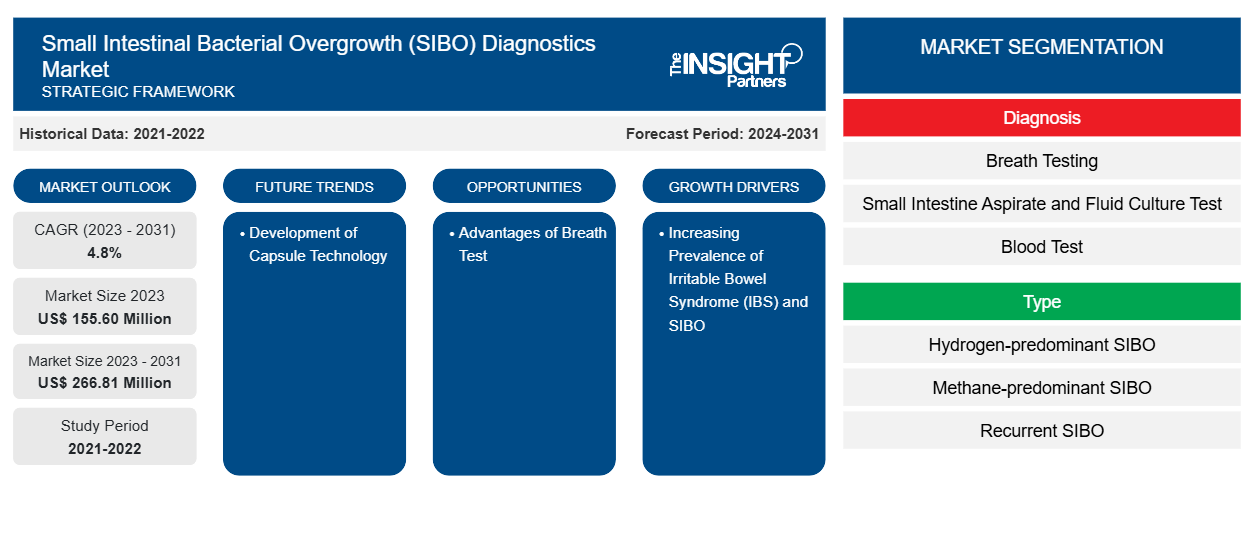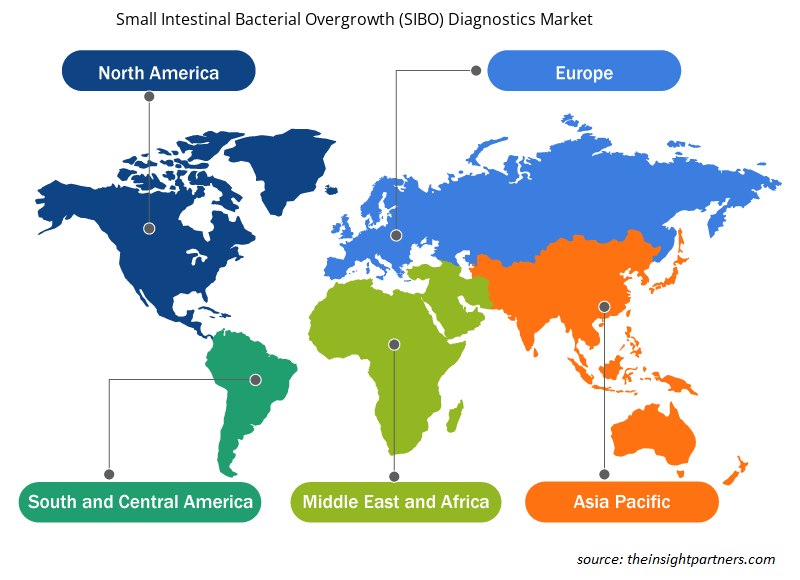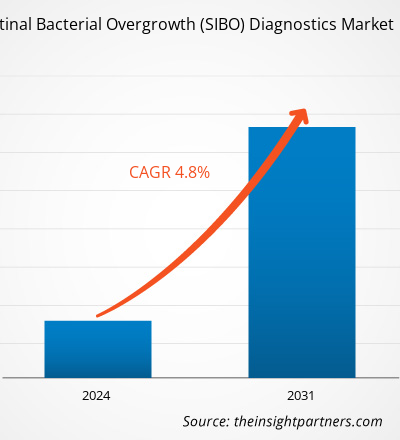Se proyecta que el tamaño del mercado de diagnóstico de sobrecrecimiento bacteriano del intestino delgado (SIBO) alcance los 266,81 millones de dólares estadounidenses para 2031, frente a los 155,60 millones de dólares estadounidenses en 2023. Se espera que el mercado registre una CAGR del 4,8 % durante 2023-2031. Es probable que las tecnologías de secuenciación de próxima generación para diagnosticar SIBO sigan siendo una tendencia clave en el mercado.
Análisis del mercado de diagnóstico de sobrecrecimiento bacteriano del intestino delgado (SIBO)
La creciente incidencia de SIBO, la creciente demanda de pruebas diagnósticas no invasivas y los avances tecnológicos en las pruebas diagnósticas están impulsando el crecimiento del mercado de diagnóstico de sobrecrecimiento bacteriano del intestino delgado (SIBO). Además, el creciente enfoque en la salud intestinal y digestiva, la expansión de la infraestructura de atención médica y la creciente conciencia y educación sobre SIBO entre los profesionales de la salud y los pacientes están impulsando el crecimiento del mercado de diagnóstico de sobrecrecimiento bacteriano del intestino delgado (SIBO).
Descripción general del mercado de diagnóstico de sobrecrecimiento bacteriano del intestino delgado (SIBO)
Geográficamente, se espera que Asia Pacífico registre la CAGR más alta en el período de pronóstico 2023-2031. India se encuentra entre las naciones de más rápido desarrollo del mundo y se encuentra entre los principales países líderes de Asia Pacífico. India es el país de más rápido desarrollo en la región de Asia Pacífico. Tiene empresas bien establecidas que operan en la industria de la biotecnología y los dispositivos médicos. Además, un número creciente de nuevas empresas que están introduciendo equipos de laboratorio que utilizan las últimas tecnologías. Mientras que el aumento de casos de diarrea, SIBO y enfermedades gastrointestinales amplía las oportunidades de crecimiento para el mercado de diagnóstico de sobrecrecimiento bacteriano del intestino delgado (SIBO) de la India. De manera similar, es probable que el creciente número de hospitales y laboratorios de diagnóstico en todo el país aumente la demanda de instrumentos y equipos de diagnóstico modernizados , ofreciendo un entorno favorable para el mercado de diagnóstico de sobrecrecimiento bacteriano del intestino delgado de la India durante el período de pronóstico.
Personalice este informe según sus necesidades
Obtendrá personalización en cualquier informe, sin cargo, incluidas partes de este informe o análisis a nivel de país, paquete de datos de Excel, así como también grandes ofertas y descuentos para empresas emergentes y universidades.
Mercado de diagnóstico de sobrecrecimiento bacteriano del intestino delgado (SIBO): perspectivas estratégicas

-
Obtenga las principales tendencias clave del mercado de este informe.Esta muestra GRATUITA incluirá análisis de datos, desde tendencias del mercado hasta estimaciones y pronósticos.
Factores impulsores y oportunidades del mercado de diagnóstico de sobrecrecimiento bacteriano del intestino delgado (SIBO)
La creciente prevalencia del síndrome del intestino irritable (SII) favorece al mercado
El síndrome del intestino irritable (SII) es un trastorno gastrointestinal que se diagnostica con frecuencia y que se caracteriza por dolor abdominal y alteración de los hábitos intestinales, con síntomas asociados como distensión abdominal, malabsorción y síntomas sistémicos. La enfermedad de Crohn y la colitis ulcerosa son tipos de SII. Provoca hinchazón en el tracto digestivo, que puede causar dolor abdominal, diarrea, fatiga, pérdida de peso y desnutrición. Según MedlinePlus, la enfermedad de Crohn es más frecuente en Europa occidental y América del Norte, con una tasa de prevalencia de 100 a 300 por cada 100.000 personas. Según los datos de Medscape, la incidencia de la colitis ulcerosa en los EE. UU. es de 10,4 a 12 casos por cada 100.000 personas, y la tasa de prevalencia es de 35 a 100 casos por cada 100.000 personas. En comparación con la enfermedad de Crohn, la colitis ulcerosa es tres veces más común. Se cree que la EII es el resultado de una multitud de interacciones ambientales y bacterianas con factores de mediación inmunológica en un huésped genéticamente susceptible. La creciente prevalencia del SII en todo el mundo se debe al cambio en el estilo de vida y los hábitos alimentarios. El sobrecrecimiento bacteriano del intestino delgado (SIBO) está ampliamente asociado con el SII. Por lo tanto, el aumento de la prevalencia del SII impulsa el crecimiento del mercado de diagnóstico del SIBO, ya que aumenta la prevalencia del SIBO.
El desarrollo de la tecnología de cápsulas es una oportunidad para el crecimiento del mercado
Los crecientes avances tecnológicos en el campo de los dispositivos médicos han ofrecido diversos productos innovadores para diagnosticar diversas afecciones complejas de la salud humana. Por lo tanto, para diagnosticar el SIBO, se está desarrollando una innovadora tecnología de cápsulas ingeridas por vía oral. Está diseñada de manera que mida in vivo el hidrógeno y el dióxido de carbono después de la ingestión de una comida con carbohidratos y brinde una alternativa tecnológicamente actualizada a la prueba de hidrógeno en el aliento actual. Se espera que la tecnología de cápsulas ayude a diagnosticar muestras de bacterias del intestino delgado. Por lo tanto, es probable que la introducción de la tecnología de cápsulas surja en el futuro próximo y contribuya a la evaluación directa y precisa del SIBO y ofrezca oportunidades de crecimiento vitales para el crecimiento del mercado.
Análisis de segmentación del informe de mercado de diagnóstico de sobrecrecimiento bacteriano del intestino delgado (SIBO)
Los segmentos clave que contribuyeron a la derivación del análisis del mercado de diagnóstico de sobrecrecimiento bacteriano del intestino delgado (SIBO) son el producto y el usuario final.
- Según el producto, el mercado de diagnóstico de sobrecrecimiento bacteriano del intestino delgado (SIBO) se divide en pruebas de aliento, pruebas de cultivo de líquido y aspirado del intestino delgado, análisis de sangre y otros. Los tipos de pruebas de aliento se subdividen en pruebas de aliento con xilosa 14C, pruebas de aliento con hidrógeno, pruebas de aliento con ácido glicocólico 14C y otros. El segmento de pruebas de aliento tuvo la mayor participación de mercado en 2023.
- Según el tipo, el mercado de diagnóstico de sobrecrecimiento bacteriano del intestino delgado (SIBO) se divide en SIBO con predominio de hidrógeno, SIBO con predominio de metano y SIBO recurrente. El segmento SIBO con predominio de hidrógeno tuvo la mayor participación de mercado en 2023.
Análisis de la cuota de mercado de diagnóstico de sobrecrecimiento bacteriano del intestino delgado (SIBO) por geografía
El alcance geográfico del informe de mercado de diagnóstico de sobrecrecimiento bacteriano del intestino delgado (SIBO) se divide principalmente en cinco regiones: América del Norte, Asia Pacífico, Europa, Medio Oriente y África, y América del Sur y Central.
América del Norte ha dominado el mercado. América del Norte es el mercado más grande en el período de pronóstico debido a la creciente incidencia de SIBO en los países, el creciente apoyo gubernamental y el creciente número de presentaciones de productos. Además, es probable que la creciente demanda de infraestructura de diagnóstico avanzada también acelere el crecimiento del mercado durante el período de pronóstico. Estados Unidos es el país más grande y de más rápido crecimiento para el mercado de diagnóstico de sobrecrecimiento bacteriano del intestino delgado (SIBO) en el mercado global. El crecimiento del mercado se atribuye principalmente a la creciente prevalencia de afecciones como síndromes de inmunodeficiencia e insuficiencia exocrina pancreática, entre otras. También se espera que la creciente prevalencia de factores de riesgo asociados con el SIBO impulse la prevalencia de la afección, lo que eventualmente ofrecerá un entorno favorable para el crecimiento del mercado de diagnóstico de sobrecrecimiento bacteriano del intestino delgado en Estados Unidos.
Perspectivas regionales del mercado de diagnóstico de sobrecrecimiento bacteriano del intestino delgado (SIBO)
Los analistas de Insight Partners explicaron en detalle las tendencias y los factores regionales que influyen en el mercado de diagnóstico de sobrecrecimiento bacteriano del intestino delgado (SIBO) durante el período de pronóstico. Esta sección también analiza los segmentos y la geografía del mercado de diagnóstico de sobrecrecimiento bacteriano del intestino delgado (SIBO) en América del Norte, Europa, Asia Pacífico, Medio Oriente y África, y América del Sur y Central.

- Obtenga datos regionales específicos para el mercado de diagnóstico de sobrecrecimiento bacteriano del intestino delgado (SIBO)
Alcance del informe de mercado sobre diagnóstico de sobrecrecimiento bacteriano del intestino delgado (SIBO)
| Atributo del informe | Detalles |
|---|---|
| Tamaño del mercado en 2023 | US$ 155,60 millones |
| Tamaño del mercado en 2031 | US$ 266,81 millones |
| CAGR global (2023 - 2031) | 4,8% |
| Datos históricos | 2021-2022 |
| Período de pronóstico | 2024-2031 |
| Segmentos cubiertos |
Por diagnóstico
|
| Regiones y países cubiertos |
América del norte
|
| Líderes del mercado y perfiles de empresas clave |
|
Densidad de actores del mercado de diagnóstico de sobrecrecimiento bacteriano del intestino delgado (SIBO): comprensión de su impacto en la dinámica empresarial
El mercado de diagnóstico de sobrecrecimiento bacteriano del intestino delgado (SIBO) está creciendo rápidamente, impulsado por la creciente demanda de los usuarios finales debido a factores como la evolución de las preferencias de los consumidores, los avances tecnológicos y una mayor conciencia de los beneficios del producto. A medida que aumenta la demanda, las empresas amplían sus ofertas, innovan para satisfacer las necesidades de los consumidores y aprovechan las tendencias emergentes, lo que impulsa aún más el crecimiento del mercado.
La densidad de actores del mercado se refiere a la distribución de las empresas o firmas que operan dentro de un mercado o industria en particular. Indica cuántos competidores (actores del mercado) están presentes en un espacio de mercado determinado en relación con su tamaño o valor total de mercado.
Las principales empresas que operan en el mercado de diagnóstico de sobrecrecimiento bacteriano del intestino delgado (SIBO) son:
- Diagnóstico Genova
- Diagnóstico de SIBO
- Diagnóstico Internacional de la Commonwealth
- Aerodiagnóstico LLC
- Prueba SIBOT
- Soluciones metabólicas inc.
Descargo de responsabilidad : Las empresas enumeradas anteriormente no están clasificadas en ningún orden particular.

- Obtenga una descripción general de los principales actores clave del mercado de diagnóstico de sobrecrecimiento bacteriano del intestino delgado (SIBO)
Noticias y desarrollos recientes del mercado de diagnóstico de sobrecrecimiento bacteriano del intestino delgado (SIBO)
El mercado de diagnóstico de sobrecrecimiento bacteriano del intestino delgado (SIBO) se evalúa mediante la recopilación de datos cualitativos y cuantitativos posteriores a la investigación primaria y secundaria, que incluye publicaciones corporativas importantes, datos de asociaciones y bases de datos. A continuación, se enumeran algunos de los desarrollos en el mercado de diagnóstico de sobrecrecimiento bacteriano del intestino delgado (SIBO):
- Owlstone Medical lanzó OMED Health, una plataforma digital y una marca dedicada y centrada en el paciente que ofrecerá a los pacientes y médicos acceso a pruebas de diagnóstico basadas en el aliento, dispositivos de punto de atención (PoC) y recursos de apoyo para una variedad de afecciones. OMED Health, que inicialmente se centró en las enfermedades digestivas, ayudará a las personas con problemas de salud intestinal a tener una mejor calidad de vida al permitir una mejor y más rápida comprensión y gestión de sus afecciones. (Fuente: Owlstone Medical, comunicado de prensa, abril de 2023)
Informe de mercado sobre diagnóstico de sobrecrecimiento bacteriano del intestino delgado (SIBO) Cobertura y resultados
El informe “Tamaño y pronóstico del mercado de diagnóstico de sobrecrecimiento bacteriano del intestino delgado (SIBO) (2021-2031)” proporciona un análisis detallado del mercado que cubre las siguientes áreas:
- Tamaño del mercado de diagnóstico de sobrecrecimiento bacteriano del intestino delgado (SIBO) y pronóstico a nivel mundial, regional y nacional para todos los segmentos clave del mercado cubiertos bajo el alcance
- Tendencias del mercado de diagnóstico de sobrecrecimiento bacteriano del intestino delgado (SIBO), así como dinámica del mercado, como impulsores, restricciones y oportunidades clave
- Análisis detallado de las cinco fuerzas de Porter y PEST y FODA
- Análisis del mercado de diagnóstico de sobrecrecimiento bacteriano del intestino delgado (SIBO) que abarca las tendencias clave del mercado, el marco global y regional, los principales actores, las regulaciones y los desarrollos recientes del mercado
- Panorama de la industria y análisis de la competencia que abarca la concentración del mercado, análisis de mapas de calor, actores destacados y desarrollos recientes para el mercado de diagnóstico de sobrecrecimiento bacteriano del intestino delgado (SIBO)
- Perfiles detallados de empresas
- Análisis histórico (2 años), año base, pronóstico (7 años) con CAGR
- Análisis PEST y FODA
- Tamaño del mercado, valor/volumen: global, regional y nacional
- Industria y panorama competitivo
- Conjunto de datos de Excel
Informes recientes
Testimonios
Razón para comprar
- Toma de decisiones informada
- Comprensión de la dinámica del mercado
- Análisis competitivo
- Información sobre clientes
- Pronósticos del mercado
- Mitigación de riesgos
- Planificación estratégica
- Justificación de la inversión
- Identificación de mercados emergentes
- Mejora de las estrategias de marketing
- Impulso de la eficiencia operativa
- Alineación con las tendencias regulatorias






















 Obtenga una muestra gratuita para - Mercado de diagnóstico de sobrecrecimiento bacteriano del intestino delgado (SIBO)
Obtenga una muestra gratuita para - Mercado de diagnóstico de sobrecrecimiento bacteriano del intestino delgado (SIBO)